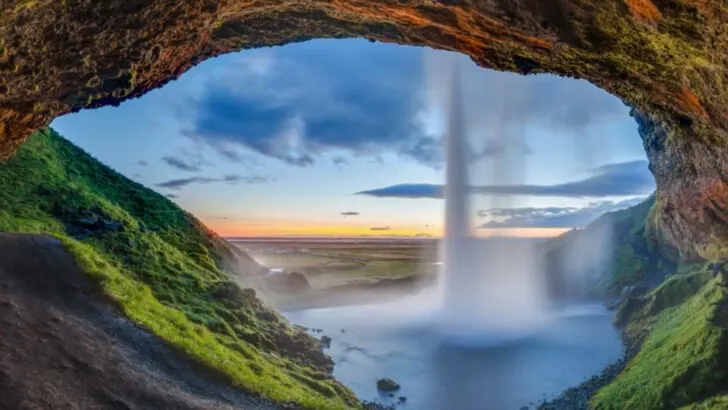Iceland is a land where waterfalls thunder down volcanic cliffs and villages cling to wild landscapes, reminding travelers that nature always takes center stage. From misty cascades that glow with rainbows to tiny towns framed by glaciers and fjords, every stop feels like stepping into another world.
These paired destinations show why Iceland is a place of raw beauty and resilient communities. Together, they make journeys across the island as breathtaking as they are unforgettable.
Gullfoss
Gullfoss, often called the “Golden Waterfall,” mesmerizes with its two-tiered cascade thundering into a rugged canyon. In summer, the sun casts rainbows across its mist, adding magic to its roar. The constant flow from the Hvítá River enhances its beauty, making it a favorite among visitors.
Historically, it was almost harnessed for electricity in the early 20th century, but local resistance preserved its natural state. This iconic waterfall remains a symbol of Iceland’s commitment to conservation and the power of grassroots activism.
Seljalandsfoss
Seljalandsfoss offers a rare opportunity to walk behind its cascading beauty. Situated along the south coast, it plunges over ancient sea cliffs, inviting explorers to experience its spray from all angles. Its unique vantage point and the surrounding meadowland create a picturesque setting.
As evening falls, the waterfall glows under the midnight sun, a sight cherished by photographers. With roots intertwined in Icelandic folklore, Seljalandsfoss is more than a waterfall—it’s a portal to a world of myths and legends.
Skógafoss
Skógafoss stands tall and proud, pouring glacial water over its 60-meter drop. Its sheer power creates a constant mist, often resulting in double rainbows that delight visitors. The waterfall’s base is a playground for photographers seeking the perfect shot.
Legend has it that a hidden treasure lies in a cave behind the torrent, a tale that adds mystery to its allure. This majestic cascade on the Skógá River is also the starting point for the famous Fimmvörðuháls hiking trail.
Goðafoss
Goðafoss, the “Waterfall of the Gods,” is steeped in history and legend. Its horseshoe shape and turquoise waters make it a visual masterpiece. According to lore, it was here that Iceland’s conversion to Christianity was symbolized by the throwing of Norse god statues into the cascade.
This act marked a pivotal moment in Icelandic history. Today, Goðafoss draws visitors with its dramatic scenery and historical significance, offering a serene yet powerful testament to the island’s cultural evolution.
Dettifoss
Dettifoss commands attention with its thunderous roar, being Europe’s most powerful waterfall. Located in Vatnajökull National Park, its sheer force is a humbling sight. The surrounding lunar landscape adds an otherworldly feel, intensifying its dramatic impact.
As the Jökulsá á Fjöllum River surges over the edge, it carves deep into the volcanic rock, creating a scene of raw natural power. This waterfall epitomizes the mighty forces shaping Iceland’s terrain, drawing both adventurers and nature enthusiasts.
Svartifoss
Svartifoss, or “Black Falls,” is renowned for its striking basalt columns resembling a giant organ. Nestled in Skaftafell National Park, its dark columns contrast beautifully with the white cascade. The unique geology inspired the design of Reykjavik’s Hallgrímskirkja church.
A short hike through verdant landscapes rewards visitors with this architectural marvel of nature. Svartifoss stands as a testament to the creative forces of volcanic activity and erosion, offering a visually stunning and academically intriguing destination.
Vík í Mýrdal
Vík í Mýrdal, Iceland’s southernmost village, captivates with its dramatic coastal scenery. The black sand beaches and towering Reynisdrangar sea stacks create a striking visual contrast. The village’s charm is amplified by its colorful houses and the iconic Vík Church perched on a hill.
Despite its small size, Vík is a hub for exploring nearby attractions like the Dyrhólaey promontory. The village stands as a testament to nature’s artistry, where the ocean’s forceful waves meet the steadfast cliffs.
Seyðisfjörður
Seyðisfjörður is a picturesque gem nestled in a narrow fjord on Iceland’s east coast. The village is famed for its vibrant arts scene, with colorful wooden houses lining its streets. A rainbow-painted road leads to the charming church, symbolizing the community’s creative spirit.
Surrounded by snow-capped mountains and cascading waterfalls, Seyðisfjörður offers a serene retreat into the heart of nature. The annual LungA Art Festival showcases local talent, further enriching its cultural landscape.
Húsavík
Húsavík, often dubbed the “Whale Watching Capital of Iceland,” offers more than just marine life encounters. The village’s setting on Skjálfandi Bay provides breathtaking views of surrounding fjords and mountains.
Traditional Icelandic wooden houses dot the landscape, adding to its quaint charm. Húsavík’s Whale Museum enriches visitors’ understanding of marine conservation efforts. This small town embodies a harmonious blend of adventure and tranquility, attracting nature lovers and conservation enthusiasts from around the globe.
Ísafjörður
Ísafjörður, nestled in the Westfjords, serves as a vibrant cultural and economic hub. With its stunning fjord views and charming harbor, it’s a gateway to exploring the region’s natural wonders. The town hosts annual music festivals, celebrating both local and international talent.
Ísafjörður’s historic buildings, painted in bright hues, reflect its maritime heritage. The fusion of dramatic landscapes and rich cultural offerings makes this town a must-visit for those seeking a unique Icelandic experience.
Borgarfjörður Eystri
Borgarfjörður Eystri is a remote haven renowned for its hiking trails and elf folklore. The surrounding mountains and colorful rhyolite rocks create a captivating backdrop for outdoor adventures. This village is a gateway to the Víknaslóðir trails, offering breathtaking vistas at every turn.
Local legends of elves and hidden people add a mystical layer to its charm. Borgarfjörður Eystri invites visitors to immerse themselves in both nature and myth, making it a unique stop on Iceland’s eastern edge.
Stykkishólmur
Stykkishólmur, located on the Snæfellsnes Peninsula, charms with its picturesque harbor and vibrant community. Known for its historic houses and thriving arts scene, the village embodies a fusion of tradition and creativity.
Its proximity to Breiðafjörður Bay offers stunning sea views and opportunities for island excursions. The Norwegian House Museum highlights local history, while the modern Library of Water art installation by Roni Horn adds a contemporary touch. Stykkishólmur is a dynamic blend of past and present, inviting exploration.

